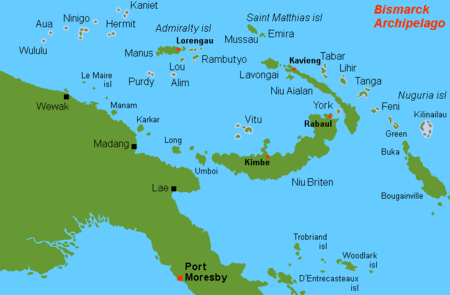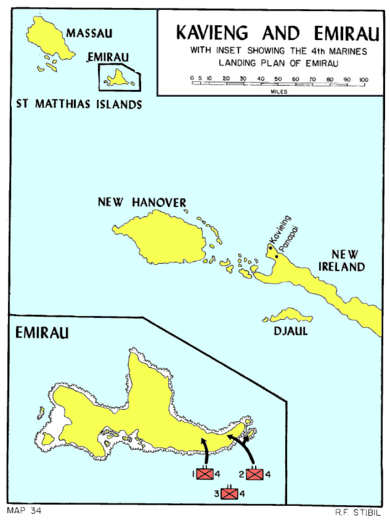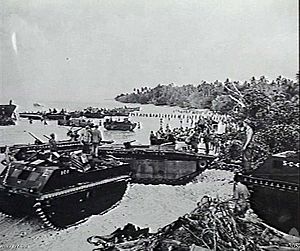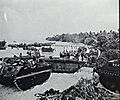Landing on Emirau facts for kids
Quick facts for kids Landing on Emirau |
|||||||
|---|---|---|---|---|---|---|---|
| Part of World War II, Pacific War | |||||||
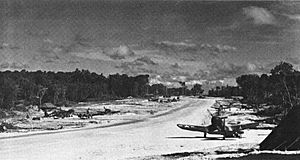 F4U Corsairs on Emirau Island in position along a taxiway to the new airport which was operational less than two months after the landing. |
|||||||
|
|||||||
| Belligerents | |||||||
| Commanders and leaders | |||||||
| Strength | |||||||
| 4,000 | |||||||
| Casualties and losses | |||||||
| 1 injured | |||||||
The Landing on Emirau was the final step in a series of military actions called Operation Cartwheel. This plan, led by General Douglas MacArthur, aimed to surround the major Japanese base at Rabaul during World War II. On March 20, 1944, nearly 4,000 U.S. Marines landed on Emirau Island. There were no Japanese soldiers on the island, so there was no fighting.
Emirau was quickly turned into an important airbase. This new base completed the ring of Allied bases around Rabaul, cutting it off from Japanese support. With Rabaul isolated, General MacArthur could then focus on moving his forces westward along the north coast of New Guinea towards the Philippines.
Contents
Why Emirau Was Important
Planning the Pacific War Strategy
In early 1943, General MacArthur proposed a plan to the U.S. Joint Chiefs of Staff (top military leaders) to advance on the Japanese stronghold of Rabaul. This plan, called the Elkton Plan, included capturing Kavieng. Kavieng was a key stop for Japanese aircraft flying from Truk to Rabaul. Taking Kavieng would cut off this route and isolate Rabaul.
After the Allied victory in the Admiralty Islands campaign in March 1944, military leaders wanted to speed up operations in the Pacific. They asked commanders for their ideas. On March 5, 1944, MacArthur suggested skipping a planned attack on Hansa Bay and instead moving directly to Hollandia in New Guinea. This area was too far for his land-based planes to cover. So, he suggested that aircraft carriers from Admiral Chester W. Nimitz's United States Pacific Fleet could provide air support.
Admiral Nimitz, however, disagreed. He didn't want his carriers to stay in the South West Pacific after the Kavieng operation, as it would interfere with his own plans for other battles. After discussions, the Joint War Plans Committee recommended canceling the Kavieng operation and instead seizing Hollandia.
The Decision to Isolate Rabaul
MacArthur's Chief of Staff, Lieutenant General Richard K. Sutherland, argued strongly against canceling the Kavieng operation. He believed it could be captured without delaying other plans. There was a debate about how much of a threat the Japanese base at Kavieng really was. Admiral Nimitz felt that attacks on Truk would soon cut off the flow of aircraft to Rabaul anyway.
On March 12, orders were sent to MacArthur and Nimitz. They were told to cancel the Kavieng operation and instead "complete the isolation of the Rabaul-Kavieng area with the minimum commitment of forces." This meant finding a way to cut off Rabaul and Kavieng using as few troops as possible. Admiral William Halsey, Jr., who commanded the South Pacific Area, thought that the geography of the area made it perfect for another "bypass" strategy, meaning they could go around a strong enemy position instead of attacking it directly.
When MacArthur ordered Halsey to occupy Emirau instead of Kavieng, Halsey quickly told Rear Admiral Theodore S. Wilkinson, who led the III Amphibious Force, to land on Emirau on March 20.
Emirau Island: A Perfect Location
Emirau (also called Emira) is a small island in the Bismarck Archipelago. It's about 25 miles (40 km) from Mussau Island and 90 miles (140 km) from Kavieng. Emirau is about 8 miles (13 km) long and 2 miles (3.2 km) wide. It's hilly and covered in thick woods. There's a plateau (flat raised land) of about 90 acres (36 hectares) inland. The weather is tropical, with high humidity and lots of rain.
On the northwest coast, there's a small harbor called Hamburg Bay. About 300 local people lived on the island. However, intelligence reports showed that the Japanese had not set up any strong bases there. Emirau was considered a good spot to build an airbase and a base for PT boats (small, fast patrol boats). A photo taken from the air on March 16 showed no signs of enemy activity or buildings.
Getting Ready for the Landing
Admiral Halsey's message reached Admiral Wilkinson on Guadalcanal on March 15. At that time, ships were already being loaded for the Kavieng operation, which was supposed to happen on March 18. That operation would have involved a much larger force of Marines and infantry.
For Emirau, a smaller force was enough: Lieutenant Colonel Alan Shapley's 4th Marines. They were joined by special units, including amphibian tractors (vehicles that can travel on land and water), tanks, engineers (called pioneers), and anti-aircraft gunners. This was the first mission for the 4th Marines since they were reformed in February 1944. Their original unit had been destroyed in the Battle of Corregidor.
Commodore Lawrence F. Reifsnider was put in charge of the landing operation. Brigadier General Alfred H. Noble commanded the troops on the island and was also slated to become the island commander. An air command was also set up for Emirau under Colonel William L. McKittrick.
Even though no resistance was expected on Emirau, strong naval and air support was provided. A group of battleships and escort carriers, along with 15 destroyers, bombarded Kavieng and the surrounding area. They fired many shells. Sadly, this bombardment made a Japanese admiral, Ryukichi Tamura, think that an invasion was about to happen. He then ordered the execution of European prisoners in Kavieng. At least 25 prisoners were killed in what became known as the Kavieng Wharf Massacre. After the war, six people involved were tried for war crimes, and Tamura was executed in 1948.
The Landing and Aftermath
The assault force arrived at the landing area at 6:05 AM on March 20. Amphibious tractors (LVTs) were launched, and troops moved into them. Vought F4U Corsair planes flew overhead to check the island one last time for any signs of Japanese forces. The first waves of troops landed right on schedule. Some boats carrying reserve troops got stuck on a reef, so the Marines had to wade ashore through knee-deep water.
The only real problem was launching the landing craft that carried the tanks. As a small group of Marines approached Elomusao Island, they thought they saw enemy activity. This caused the amphibious tractors and a destroyer to open fire, and one Marine was injured by a shell fragment. However, local people on the island told the Marines that the Japanese had left Emirau two months earlier. Only a small group remained on Mussau Island.
Supplies started coming ashore around 11:00 AM. By nightfall, about 3,727 troops and 844 tons of cargo were on the island, and the ships sailed away. Within a month, a total of about 18,000 men and 44,000 tons of supplies had been landed.
Reports suggested there were Japanese fuel and food storage areas on Mussau, and a radio station on a nearby island. So, on March 23, destroyers shelled these areas. On March 27, a destroyer stopped a large canoe carrying Japanese soldiers about 40 miles (64 km) south of Mussau. The Japanese soldiers fired their rifles and machine guns, but the destroyer returned fire, destroying the canoe and killing everyone on board. This was the only fighting that happened in the St. Matthias Group of islands.
Building the Base
The U.S. Navy's Seabees (construction battalions) quickly began building the base. Several Seabee battalions arrived between March 25 and April 14. They built many important facilities:
- A base for PT boats.
- A floating drydock and slipway for landing craft.
- Many miles of roads.
- Housing for troops.
- Ammunition storage areas.
- Runways for aircraft.
- Sawmills to cut wood.
- Harbor facilities, warehouses, and fuel storage areas for aviation gasoline (avgas).
Two airfields were built, named Inshore and North Cape. These were designed for heavy bombers, each 7,000 feet (2,100 m) long and 300 feet (91 m) wide. The Inshore airfield could park 210 fighters or light bombers, while North Cape could hold 84 heavy bombers. Both airfields had control towers, lighting, and medical facilities.
The aviation fuel storage area had large tanks holding thousands of barrels of avgas, plus a reserve stored in drums. Three hospitals were set up: a 100-bed naval hospital, a 160-bed Army field hospital, and a 150-bed hospital. Hamburg Bay's anchorage could hold up to five large warships. Port facilities included eight cranes, refrigerated storage, and covered storage space. The port could handle 800 tons of cargo each day. All these facilities were connected by 40 miles (64 km) of coral-surfaced roads that could be used in any weather.
All this construction work was finished by August. After that, a maintenance unit took over keeping everything in working order. All the main construction battalions left by December.
Who Guarded the Island
The 4th Marines, who first landed on Emirau, were replaced as the island's defenders by the 147th Infantry on April 11, 1944. The next day, Major General James T. Moore, a Marine aviator, took over as island commander. In June, the 147th Infantry was replaced by the 369th Infantry.
In August, General MacArthur decided that the Australian Army would take over guarding Emirau. The Australian 8th Infantry Battalion arrived on September 30 to become the new garrison. They met a small group from the ANGAU (Australian New Guinea Administrative Unit) who had been on the island since May.
Marine Aircraft Group 12 operated from Emirau until December, when it moved to Leyte. Its place was taken by squadrons from the RNZAF (Royal New Zealand Air Force). On March 20, 1945, General MacArthur allowed the garrison to be reduced to just one company of the 8th Infantry Battalion. In June 1945, even this small group was withdrawn. The Seabee maintenance unit also left that month. The RNZAF kept a bomber-reconnaissance squadron at Emirau until July 1945 and a fighter squadron until August, when all forces finally left the island.
Images for kids
-
F4U Corsairs on Emirau Island in position along a taxiway to the new airport which was operational less than two months after the landing.


